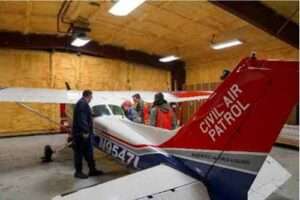
CHUGIAK, Alaska — In a small general aviation airport located on the east shore of the Knik Arm, the Birchwood Composite Squadron became a hub of activity as Civil Air Patrol members converged for a three-day training exercise that took flight Nov. 3 at the Birchwood Airport.
The training, a pivotal part of the CAP wing-wide Search and Rescue Exercise, is a quarterly event designed to test participants’ skill sets, leadership qualities, and resourcefulness.
Lt. Col. Brian Porter, Alaska Wing director of operations, explained that the SAREX brought senior members and cadets from across the state to train together in a virtual and in person environment, creating a unique setting where they could practice and refine the essential capabilities that CAP stands ready to deploy daily.
“There are three missions in the Civil Air Patrol, and they are all linked together,” said Porter. “First and foremost, we do emergency services, the inland search and rescue for the Air Force, and then to support that we have aerospace education both within our organization and outside outreach to the community and then finally the cadet program which is building aviation leaders of tomorrow.”
During the exercise at Birchwood Airport, cadets from the South-Central region, including Lake Hood Cadet Squadron and JBER Arcturus, Polaris and Birchwood Composite Squadrons, showcased their dedication to readiness as they teamed up for ground team skills training.
For search and rescue teams, the ability to navigate accurately in the vast wilderness could mean the difference between life and death for those in distress. Porter emphasized the importance of having cadets and senior members well-versed in land navigation and proficient in locating distress beacons, on downed aircraft or personal locator beacons used by hikers.
“It’s also an incredible opportunity for these young people to get their hands dirty with real leadership and real problem solving in the field under austere conditions,” said Porter, sharing that he enjoys teaching these skills to cadets who can apply them in their lives either as pilots or any profession that they might pursue.
Participants camped overnight in their shelters at the bivouac area, providing a taste of the harsh conditions they might face during a real mission. This experience not only built resilience but also fostered camaraderie among the participants.
Fifteen-year-old Cadet Capt. Rick Benedict, assigned to the Birchwood Composite Squadron, has been with CAP for three years and participated in the exercise as part of the advanced ground team.
Benedict said that he was not only able to help newer cadets with land navigation and learn how to search for electric signals from downed aircraft but also practice fire-starting techniques and proper fire watch procedures.
“[The exercise] helps cadets learn how to do proper search and rescue techniques,” said Benedict. “They are staying out here overnight, so they’ll learn a lot about fire and shelter and a good bit about safety.”
The commitment, dedication, and skills demonstrated during the exercise underscored CAP’s vital role in ensuring the safety and security of Alaskans. CAP units are charged through their federal charter with aiding in search and rescue, disaster relief and mitigation, as well as homeland security.
The CAP is the official auxiliary of the U.S. Air Force and operates as a federally charted nonprofit organization. Beyond their service to the Air Force, CAP members are shaping the future leaders of tomorrow, instilling them with values of teamwork, leadership, and preparedness.
In Alaska, CAP is administratively aligned with the Alaska Department of Military and Veterans Affairs, making them a valuable and accessible resource for the commissioner, Maj. Gen. Torrence Saxe, during a range of emergencies. In the event of a federal or state disaster, CAP units and resources can work side-by-side members of the Alaska Organized Militia during a coordinated response.
“These cadets out here are adding to their skills and experience, all while contributing to CAP’s part of the DMVA mission and directly supporting Alaska’s aviation community,” said Porter. “These young volunteers are making a real difference.”
Benedict aspires to leverage his experience with CAP as part of his application into the Air Force Academy. From character development and leadership opportunities to a chance to accrue community service hours, Benedict said that CAP offers a valuable pathway for anyone interested in a range of career options.
“If they’re interested in joining the military or just becoming a pilot or even cyber security is one of the new things that [we] have been implementing recently,” said Benedict.
Porter further explained that it takes a whole host of people to be able to launch an aircraft and just like in the Air Force, the Civil Air Patrol has several specialties.
“We have pilots, and we have observers and scanners who are doing the work in the air but on the ground, we have ground teams, and we have mission-based staff,” said Porter. “Everything ranging from finance officers to public affairs.”
CAP provides a comprehensive cadet program for young people aged 12 to 20, focusing on not just leadership development but also character building, physical fitness, and aerospace education. Cadets partake in various activities, including leadership training, search and rescue missions, and aviation-related experiences, all designed to prepare them for future roles as leaders within CAP or in diverse careers.
“I just encourage people to join the Civil Air Patrol,” said Benedict. “It’s a lot of fun. There’s a lot of fun things we do here you know. Tell your friends, tell your family.”
###
